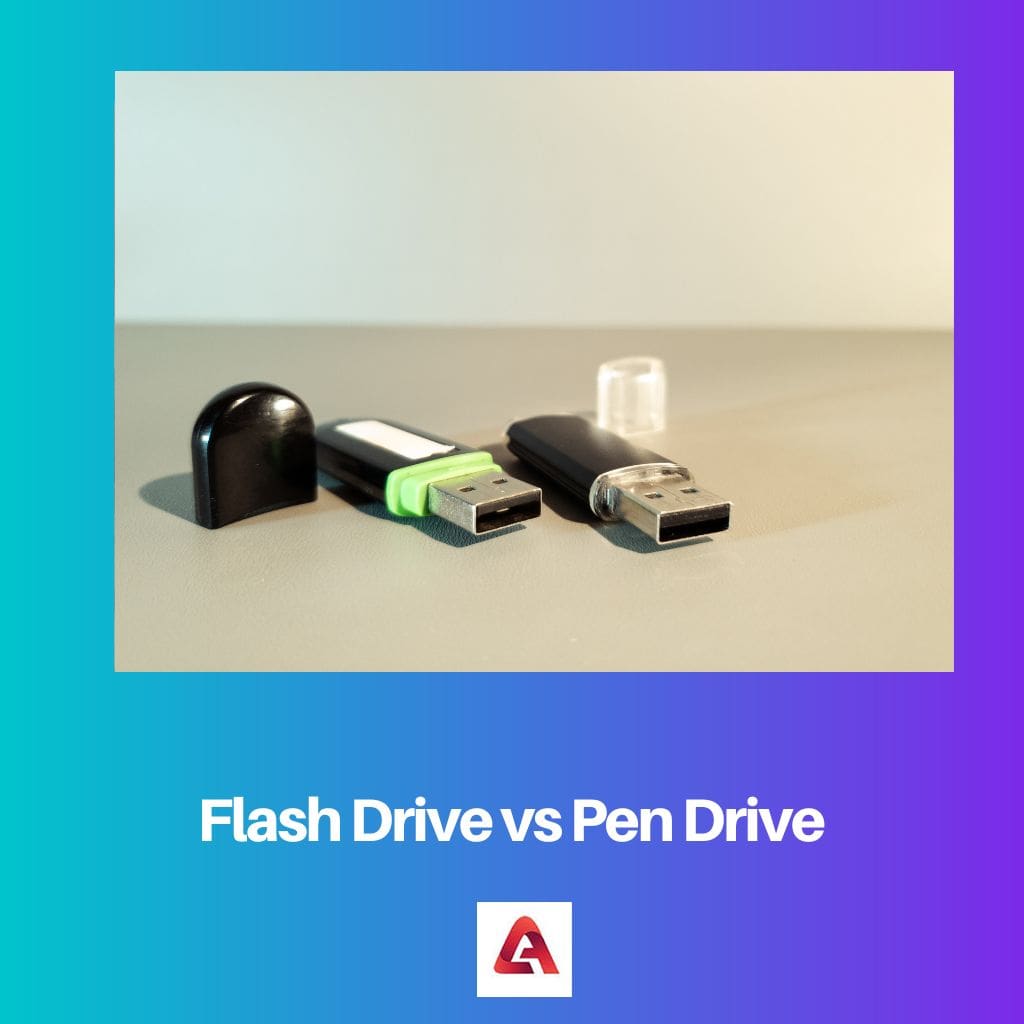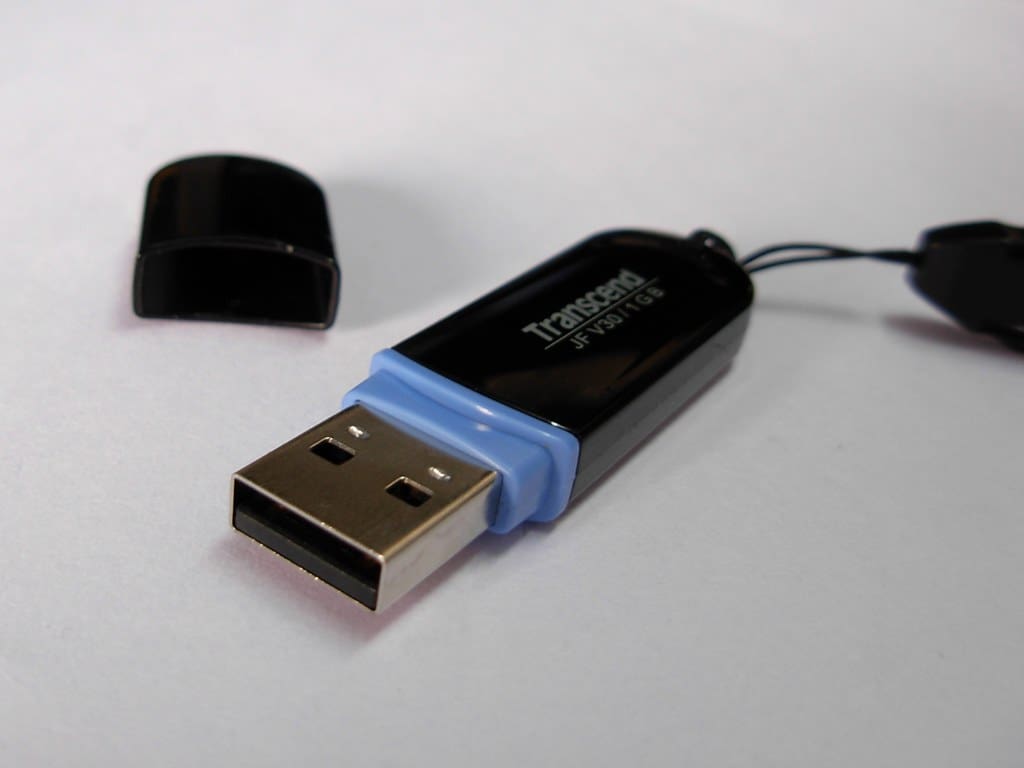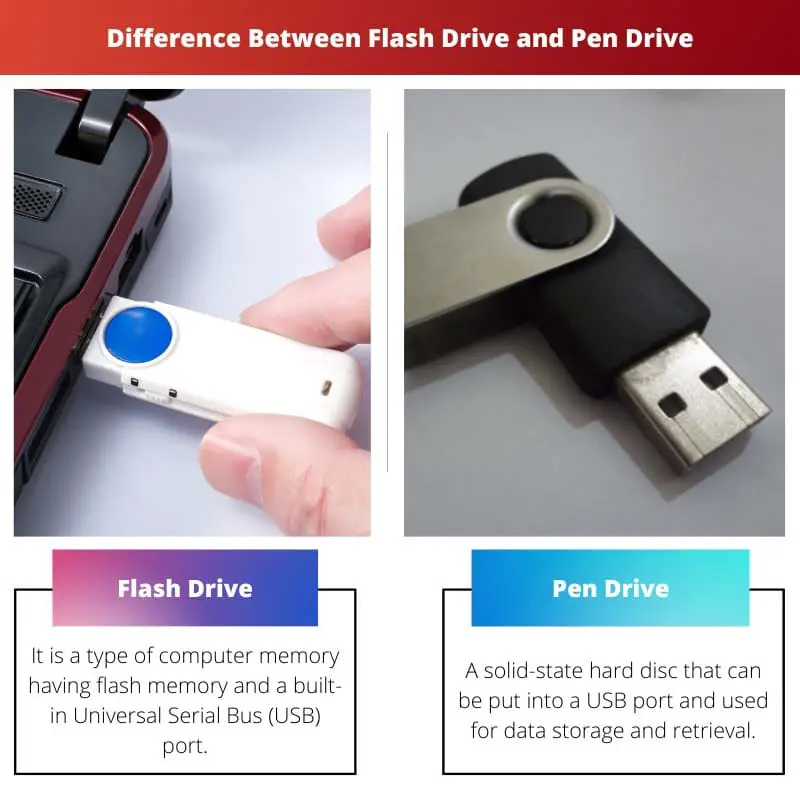In a world where every minute equals a big amount of data creation, everyone needs devices that are compatible with their requirements and can be used for the storage of data.
These vary in many domains like their ideal use, capability, or conditions where they can be used. Know about what might be your perfect device.
Key Takeaways
- Flash drives and pen drives use flash memory for data storage, but “pen drive” is more commonly used in India and other countries.
- Both devices are portable, lightweight, and convenient for data transfer and storage.
- Flash and pen drives are available in various storage capacities, ranging from a few gigabytes to multiple terabytes.
Flash Drive vs Pen Drive
A flash drive is a small, portable storage device that connects to a computer’s USB port. The device contains a solid-state memory chip that can store data and transfer it quickly between devices. A pen drive is a type of flash drive that is designed to look like a pen. It is a small, cylindrical device with a USB connector on one end and a cap on the other.

Each storage device having non-movable elements is referred to as a flash drive. Before the invention of flash drives, pc users stored modest quantities of data on floppy discs & CDs.
Whenever a pc user inserts a disc or CD into a computer, the device is read by moving elements, such as with a laser scanning a CD.
A pen drive is a compact disc that is used to share information across many systems. The name was inspired by the pen’s resemblance.
It can be used on any computer that has a USB port. It replaced the floppy disk and other storage devices as it was compact and could store more information.
Comparison Table
| Parameters of Comparison | Flash Drive | Pen Drive |
|---|---|---|
| Description | It is a type of computer memory having flash memory and a built-in Universal Serial Bus (USB) port. | A solid-state hard disc that can be put into a USB port and used for data storage and retrieval. |
| Invention | 1999 by M-Systems | 2001 by phison |
| Use | Can be used in many forms | as mobile USB storage device |
| Data is stored | Stored in the form of flash memory | Stored in memory chips |
| Capacity | Maximum up to 256GB | Maximum up to 64GB |
What is Flash Drive?
A USB flash drive, known as a USB memory stick, is a flash memory device. A USB flash drive communicates with a computer via a USB interface, which is highly convenient since it does not require additional software.
A USB flash drive is made up of a compact printed circuit board containing flash memory that is housed in plastic as well as metal container.
Whenever the flash drive is inserted into a USB connection that supplies power, it becomes active. This signifies it’s a memory device that can store and transmit data using USB (universal serial bus) connections.
The data here on the device is saved or destroyed electrically in flash memory. Around 1998, Trek patented a series of data storage devices, and around 2000, Trek registered a group of data-storage devices.
M-System filed a patent for the Flash drive in 2001, as well as a patent implementation. USB0.9, USB1.0, & USB1.1 were used to calculate the first data transfer speed, which varied from 0.9 – 12Mbps.
Users felt that it was insufficient, so USB 2.0 with a capacity of 480Mbps was released in 2000. USB 3.0 was introduced around 2008, with something like a data transfer speed of up to 5 Gbps, whereas USB 3.1 (released in 2013) has been improved to a super-fast 10 Gbps mode.
Since about Mar 2016, flash drives having capacities ranging from 8 – 256 GB are popular, with 512 GB and 1 TB models selling less frequently.

What is Pen Drive?
A specific form of universal serial bus (USB) USB stick is referred to as a “pen drive.” Pen drives are flash storage cards with NAND flash technology that may be connected to a device’s USB interface.
Its term “pen” defines the size of the device. This flash drive is small enough to fit inside the palm of your hands or hung on a lanyard. It also is flat and rectangular, like a highlighter pen’s shape.
Data is stored on pen drives. These detachable and rewritable flash drives range in storage capacity from 64 MB to 32 GB. Pen drives are frequently purchased by techies as backups or replacements for CD-Rs or floppy discs.
The typical Joe, on the other hand, unintentionally buys pen drives in the shape of iPods & MP3 players. The most common kind of pen drives nowadays are iPods & MP3 players. And their circuit boards are the secret to their success.
A little printed circuit board makes up a pen drive. This circuit board acts as a stable foundation for such pen drive’s form as well as a way of data collection.
The circuit board’s microchip can retrieve data using only a small amount of electrical power. It’s based on the old EEPROMS technology, which enables both writing and erasure.
Whenever a pen drive is plugged into a USB port, it turns on. It is otherwise inactive. The USB connector allows the pen drive to access data on a particular computer.
Most pen drives are compatible with practically every USB host/port on a desktop because they are formatted using the FAT as well as FAT 32 file systems.

Main Differences Between Flash Drive and Pen Drive
- The difference between a flash drive and a pen drive is that a flash drive uses flash memory for storage and has an inbuilt USB connector, but a pen drive is a solid-state device that may be used for data storage and interchange and can be plugged into a USB port.
- The inventions of both of the devices are different. Flash drive was invented by M-Systems in 1999 and modified later whereas pen drive was divided by phison in the year 2001.
- The application of a flash drive can vary in a big range whereas a Pen drive can be used as a mobile USB storage device.
- The data stored in a flash drive is in form of flash memory whereas pen drive stores data in form of memory chips.
- The maximum capacity of a flash drive ranges up to 256 GB whereas Pendrive storage can go up to 64GB.

- https://tobaccocontrol.bmj.com/content/28/1/110.abstract
- https://dl.acm.org/doi/abs/10.1145/1165573.1165674?casa_token=Z5Lh-nq_ODMAAAAA:Rbi_6Cvj9HxA099916BFlJgqSrtUDruqXjTVQn1xblYBWbJ3pg-6oHdLenYtlUBN4_lTLv0aLt4
Last Updated : 13 July, 2023

Sandeep Bhandari holds a Bachelor of Engineering in Computers from Thapar University (2006). He has 20 years of experience in the technology field. He has a keen interest in various technical fields, including database systems, computer networks, and programming. You can read more about him on his bio page.

Great explanation, one of the best articles related to this topic I have ever read
I couldn’t agree more, Ehunt.
It’s true, the post was very detailed and enlightening.
This article was very informative, I could learn a lot from it.
There was too much emphasis on the history and not enough on the technology.
Interesting. It’s great to see that this article includes an extensive explanation of the specifications of both flash drive and pen drive.
The comparison table provided a clear vision of the differences between these two types of devices.
Not bad, but other articles about the same theme were more interesting.
You have high expectations Sabrina13.
I’m sorry to hear that, Sabrina13, we can send your feedback to the admins.